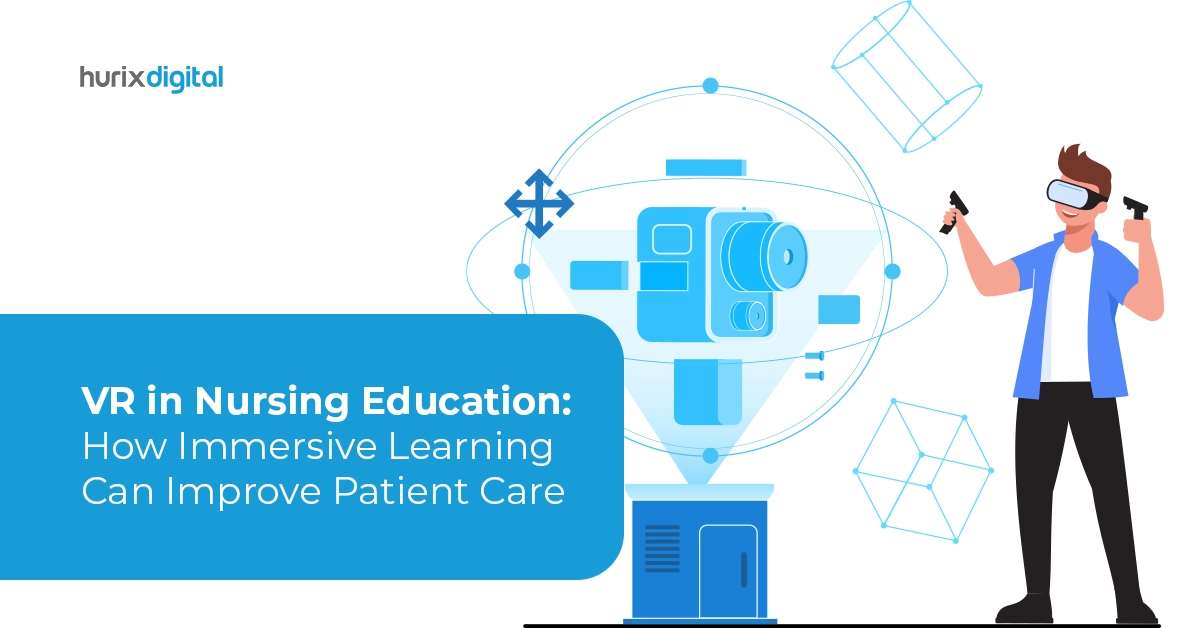
VR in Nursing Education: How Immersive Learning Can Improve Patient Care
Summary
Learn how virtual reality (VR) can enhance nursing education and improve patient care. This article discusses the benefits of immersive learning technologies in nursing training.
As a futuristic technology, Virtual Reality (VR) provides highly realistic experiences that simulate real-life scenarios. It has rapidly evolved into an effective learning tool in various fields, including healthcare. VR in nursing education has the potential to revolutionize patient care through immersive learning.
Given its ability to create interactive environments that facilitate putting theory into practice, VR has gained considerable importance in the educational landscape.
According to a market report, the global VR in education market is expected to grow to $42.40 billion by 2032, expanding at a CAGR of 28.5%. This is an indication of the increasing influence of this technology on the education sector.
Read on as we take you through how VR applications in nursing education can be a game-changer in patient care. Let’s start!
Table of Contents:
- VR in Nursing Education: A Brief
- VR Applications in Nursing Education
- Benefits of VR for Nursing Education
- Wrapping Up
VR in Nursing Education: A Brief
Virtual reality in nursing education refers to the use of immersive technology to simulate real-life medical scenarios for training and patient care.
By creating 3D interactive environments, this technology offers nursing students the opportunity to polish their skills and enhance their knowledge in a controlled environment. It facilitates the development of competence and confidence in clinical practice.
Virtual simulations for nursing skills enable students to gain in-depth clinical experience without risking the safety of patients. Such simulations involve using specialized equipment that empowers students to interact with their digital surroundings. These may include VR headsets, controllers, etc.
Also Read: AI Healers: Illuminating the Evolving Role of Artificial Intelligence in Public Health Education
VR Applications in Nursing Education
Immersive healthcare training introduces nursing students to various patient conditions and the risks they may encounter when dealing with different healthcare scenarios. It also helps them acquire the skills required to address the issues effectively.
Here are some of the major applications of VR in nursing education:
1. Simulation of Healthcare Procedures
Virtual reality can facilitate recreating different healthcare conditions that enable nurses to practice their patient-care skills repetitively.
When it comes to nursing education, learning to ensure patient safety assumes immense importance. Virtual simulations of medical procedures allow nursing students to get acquainted with diverse situations. This paves the way to gain hands-on experience in handling different healthcare scenarios and improve their efficiency in providing patient care.
In other words, VR allows nursing students the scope to practice their skills in a risk-free environment before handling real patients.
2. Symptom Assessment and Diagnosis
Virtual reality in nursing practice can simulate medical scenarios where nurses are required to assess symptoms, identify crucial signs, and make diagnostic decisions.
Different medical conditions require different interventions. VR provides nursing students with realistic experiences of dealing with virtual patients exhibiting different medical conditions. Thanks to this technology, students can improve their competency in symptom assessment and clinical decision-making.
By developing their ability to assess and recognize symptoms, nurses can gain confidence in prioritizing patient needs in real life.
3. Real-Time Response to Emergency Situations
VR simulations can create healthcare scenarios that demand immediate response and real-time decision-making to prioritize patient care. These can include situations like trauma incidents, cardiac arrests, serious accidents, etc.
Immersive learning in healthcare hones nursing students’ ability for prompt response by familiarizing them with such dynamic situations. Students learn to assess situations, apply their knowledge of emergency protocols, and respond in real time to ensure patient care.
Whether it’s fostering critical thinking skills or making effective decisions under stressful circumstances, VR and immersive learning can play significant roles in improving outcomes.
4. Fostering Cultural Competency
VR simulations for nursing students can boost their cultural competency by creating virtual patients from diverse cultural backgrounds.
When students engage with virtual patients from different backgrounds, they learn to comprehend and address their unique needs. Such experiences offer them the opportunity to understand the perspectives of patients belonging to different cultures.
This, in turn, enhances their cultural competency and enables them to foster empathy in patient care.
5. Prevention of Errors
A core area of enhancing nursing training with VR is risk management and error prevention. Virtual reality can create simulations focused on potential risks and errors related to patient care.
VR technology allows nursing students to identify and minimize risks, comply with safety protocols, and learn from mistakes without jeopardizing the safety of real patients.
Due to the simulations, they can learn continuously and improve their skills in risk management and the prevention of errors without compromising the safety of real patients. Such training can prepare students for the dynamic challenges in patient care and contribute to patient safety.
Benefits of VR for Nursing Education
Implementing VR into nursing education offers several benefits that contribute to enhanced learning outcomes. Some of the top benefits of incorporating VR in nursing education include the following:
1. Improves Learning Experiences
VR ensures highly immersive healthcare training. By offering interactive learning experiences, this innovative technology engages students and encourages them to take part in the learning process.
The realistic simulations allow students to understand complex clinical procedures and concepts smoothly, thus making it easier for them to absorb and retain knowledge.
2. Bridges the Gap between Theory and Practical Scenarios
VR simulations for nursing students help to address the challenge of closing the gap between academic knowledge and its application in the real world.
By offering immersive practical experiences, this technology enables students to apply their academic knowledge to real-world scenarios that have been created virtually. It helps students gain an enhanced comprehension of the subject matter before applying it to patient care.
3. Enhances Training Effectiveness
Virtual reality allows students to experience, understand, and practice subject matter and concepts at their own pace. Using VR simulations for repeated practice enables students to build and improve their skills effectively. Such learning experiences help them master the subject matter within a short time and with better efficiency.
4. Offers Cost-Effective Training Solutions
Healthcare training in a traditional setting usually requires the use of expensive equipment. VR technology comes across as a more affordable solution to the training needs of nursing students.
Training institutions can leverage this technology to conduct training at a much lower cost compared to that needed for setting up a clinical simulation lab and maintaining it. Further, it enables training to be conducted remotely, thus eliminating the expenses related to attending training sessions physically.
Also Read: The Future of Training: How eLearning is Revolutionizing Healthcare Education
Wrapping Up
VR in nursing education has the potential to revolutionize patient care. This innovative technology can engage students through experiential learning. By transforming the learning process for nursing students, it can facilitate enhanced learning outcomes and improved patient care.
If you’re looking for the right platform to create simulated learning experiences for healthcare training, Hurix Digital can help.
Our team can collaborate with you to design immersive and interactive VR experiences that simulate real-world patient care scenarios, allowing nursing students to practice critical skills in a safe and controlled environment.
Contact us today!

Senior Vice President
A Business Development professional with >20 years of experience with strong capability to sell new solutions and develop new markets from scratch. New Market Entry Specialist with experience of working in two of the largest emerging markets – China & India. Also covered other key markets in APAC, US, EU & ME. Exceptional experience of conceptualizing, ideating and selling new learning technologies like VR AR, etc. across multiple industry verticals.




